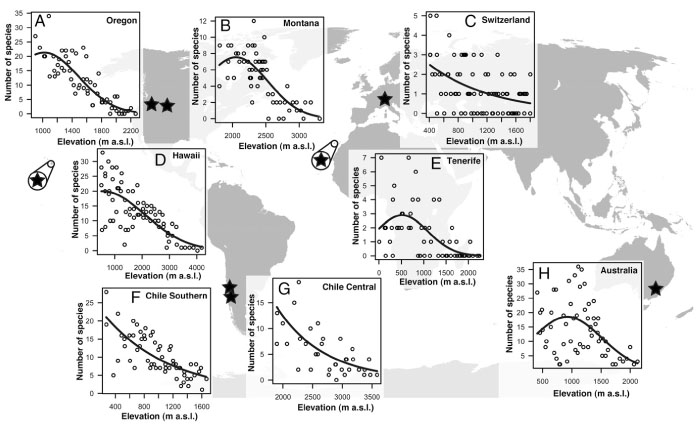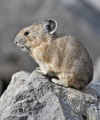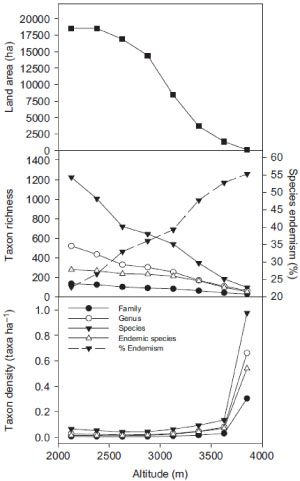 |
|
|
|
|
|
|
Two different trends regarding species diversity in the alpine can be observed. On the one hand, upward shifts of species result in an increase in species richness at the local scale in many regions, especially in summit regions where usually a relatively high amount of open space is available. On the other hand, in some areas a reduction of species numbers has been observed, e.g. in many Mediterranean mountains, where warming is accompanied by increasing desiccation. |
 |
| 1 - Development of species number (a) and dissimilarity between summits (b) of the Bernina region, Switzerland (from Jurasinski 2007) |
|
|
|
Typical winners of climate change are shrubs and graminoids, whereas mosses and lichens usually decline in abundance (fig. 2). |
 |
| 2 - Elmendorf et al. (2012) synthesized data on plant height and abundance from 61 in-situ warming experiments of up to 20 years duration, conducted in tundra sites worldwide. Averaged over all sites, mean canopy height increased by 30% to 45%. Warming significantly increased dead plant material and shrubs (especially deciduous, low and tall shrubs), while mosses and lichens decreased. The response of plant groups to warming differed with ambient summer temperature and soil moisture, the tallest growth forms normally being favoured. The tallest growth forms in cold areas tend to be herbaceous plants (frequently graminoids), whereas the tallest growth forms in warm areas are woody plants (low and tall shrubs). Accordingly, the groups that increased most in abundance under simulated warming were graminoids in cold regions and primarily shrubs in warm regions. Dwarf shrubs, which are more common in colder tundra regions, mostly declined under experimental warming. |
|
In mid-species ranges and at wetter sites shrubs will probably considerably expand also in future. This will entail changes in ecosystem characteristics like soil temperature, soil-atmosphere exchange of water, carbon and nutrient cycling, and species composition. The increasing dominance of a few competitive species that profit from climate change will probably lead to a declining species diversity in the long run. |
|
|
|
Species may go extinct locally, especially were elevated temperature is accompanied by drought or increased disturbance, e.g. due to permafrost melt. In contrast, widespread extinctions seem unlikely, but there is the danger of genetic losses due to local extinction, but also as a result of fragmentation of habitats due to more intensive land use. As migration between mountain systems and even between neighbouring summits is naturally constrained, species with restricted local distributions run a higher risk of (local) extinction (table 1), among these many endemic species. Table 1 - Likely loosers and winners of climate change (from Körner 2009)
|
3 - Pika (Ochotona princeps) |
|
Different taxonomic groups seem to be threatened unequal, with butterflies and spiders being less threatened than vascular plants and beetles probably due to their higher colonization ability. Generally, low competitive species will suffer from increased competition by newly arriving species. But for mountain ranges reaching into the nival life zone, with increasing altitude areas with low plant cover expand, so most species will be able to reach suitable microsites at least in the medium term.
|
|
|
|
In many temperate mountain ranges, the diversity of endemic species is highest in peripheral or isolated mountain chains with relatively low summits at or above the tree line, where glaciations were less severe. These endemits are at risk of extinction when treeline is shifting upward. But also other endemic species are threatened. Whereas plant diversity usually decreases with increasing altitude, the diversity and number of endemic species standardized for area are often quite high at high altitudes (fig. 4). Therefore, the observed upward shift of lower elevation species may be a threat to overall alpine biodiversity in the long run. |
4 - Altitudinal variation in land area (top), plant taxon richness and species endemism (centre)
and plant taxon density (bottom) in the Central Mountain Range of Taiwan (from Jump 2012) |
|
|
|
Neophytes (plant species which are non-native to a geographical region, and were introduced in recent history; often, neophytes are defined as plant species that were introduced after 1492) represent an increasing problem for many habitats. Yet, at present, the occurrence of alien invasive species in alpine regions is usually low as alien species richness decreases with elevation (fig 5). Almost only generalist species reach high elevations and often they are restricted to disturbed sites like roadsides. |
 |
| 5 - Relationship between non-native species richness along roadsides and elevation in eight mountain regions around the world (from Alexander et al. 2011) |
|
Nevertheless, some non-native invasive species have established in undisturbed alpine plant communities with negative effects on native species. For example, Taraxacum officinale is an invasive neophte in the Andes of Central Chile (fig. 6). Whereas single individuals of this plant can have facilitative effects on pollinator service or seed output in surrounding native species, the presence of five individuals of T. officinale negatively affected these reproductive variables. The few alien species that have caused environmental damage in mountains have established relatively recently. Hence, an increased invasion risk and management challenge can be expected in the future because of climate change and a more intense anthropogenic land use (fig. 7). |
6 - Taraxacum officinale in the Andes of Central Chile (photo: Anibal Pauchard). Whereas single individuals of T. officinale can have facilitative effects on pollinator service or seed output in surrounding native species, the presence of five individuals of T. officinale negatively affected these reproductive variables (Munoz and Cavieres 2008). |
 |
7 - Factors affecting mountain plant invasions (from Pauchard et al. 2009) Historically, introductions took place mainly at lower elevations. With increasing altitude, human disturbance and propagule pressure decreased, whereas climatic severity increased. Therefore, only climatic generalists with high dispersal ability, phenotypic plasticity or rapid evolution were able to reach the alpine. |
|
|
|
Mountain Invasion Research Network Biochange Genetic diversity, contemporary evolution and the maintenance of biodiversity in changing alpine environments |
|||
13 August 2018 |
||
| |
||


